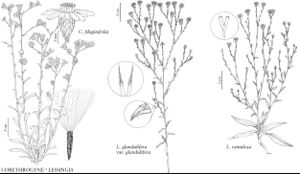Difference between revisions of "Corethrogyne"
in A. P. de Candolle and A. L. P. P. de Candolle, Prodr. 5: 215. 1836.
imported>Volume Importer |
(No difference)
|
Latest revision as of 19:57, 29 July 2020
| Taxon | Illustrator ⠉ | |
|---|---|---|
 | Corethrogyne filaginifolia Lessingia glandulifera var. glandulifera Lessingia ramulosa | Barbara Alongi Yevonn Wilson-Ramsey Yevonn Wilson-Ramsey |
Perennials or subshrubs, mostly 10–100 cm (taprooted, eventually ± woody, branched). Stems decumbent to ascending or erect, branched from bases or ± throughout, usually densely white-tomentose, sometimes glabrate and/or glandular distally. Leaves cauline (at flowering), often crowded at bases of stems; alternate; sessile or bases of blades ± decurrent onto petioles; blades 1-nerved, ovate to spatulate, oblanceolate, or linear (sessile, smaller, bractlike distally), margins entire or toothed, faces glabrous or hairy, sometimes stipitate-glandular and/or gland-dotted as well. Heads radiate, borne singly or 2–20+ in loose corymbiform arrays. Involucres hemispheric to campanulate, turbinate, or cylindric, (6–14 ×) 3–10 mm. Phyllaries 30–90+ in 3–9 series, 1-nerved (flat), narrowly lanceolate to linear, unequal, cartilaginous to scarious, margins little, if at all, scarious (apices often spreading to squarrose, herbaceous), abaxal faces usually hairy (floccose-tomentulose, glabrate, glabrescent, or tomentose) and gland-dotted, granular-glandular, or stipitate-glandular. Receptacles convex, pitted, epaleate. Ray-florets 10–43 in 1 series, neutral; corollas purplish through violet and pink to white (laminae ± linear). Disc-florets 12–120+, bisexual, fertile; corollas yellow (actinomorphic), tubes shorter than very narrowly cylindric throats, lobes 5, erect, narrowly lanceolate (equal); style-branch (linear, yellowish-hispid) appendages blunt to subulate (lengths 1/3–1/2 stigmatic bands). Cypselae cuneiform to linear, not compressed, 5–7-ribbed, faces puberulent to pilose; pappi persistent, of 35–65, distinct, brownish to reddish, unequal, coarse, barbellate, apically attenuate bristles in 1–2 series. x = 5.
Distribution
w North America, nw Mexico
Discussion
Species 1.
Some local populations and regional population systems of corethrogynes present distinct general appearances, and the plants have been variously partitioned into three to seven or more species with various numbers of infraspecific taxa (33 basionyms have been linked to the name Corethrogyne). M. A. Lane (1992) referred the plants to a single species with two varieties within Lessingia, and J. P. Saroyan et al. (2000) treated them as a single species with two varieties within Corethrogyne. We take the consolidation one step further and recognize a single, polymorphic species with no infraspecific taxa. For further discussion and additional synonymy, see Saroyan et al.
Selected References
None.
Lower Taxa
"[" is not declared as a valid unit of measurement for this property."]" is not declared as a valid unit of measurement for this property.